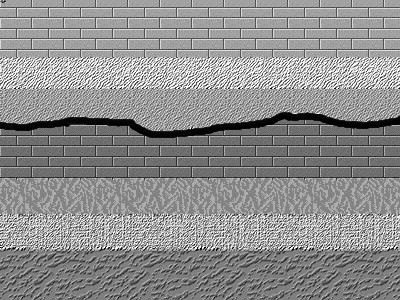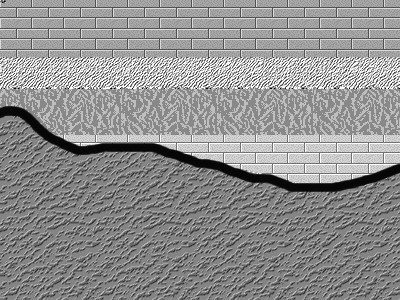|
Unconformity
An unconformity is a buried erosional or non-depositional surface separating two rock masses or strata of different ages, indicating that sediment deposition was not continuous. In general, the older layer was exposed to erosion for an interval of time before deposition of the younger layer, but the term is used to describe any break in the sedimentary geologic record. The significance of angular unconformity (see below) was shown by James Hutton, who found examples of Hutton's Unconformity at Jedburgh in 1787 and at Siccar Point in 1788. The rocks above an unconformity are younger than the rocks beneath (unless the sequence has been overturned). An unconformity represents time during which no sediments were preserved in a region or were subsequently eroded before the next deposition. The local record for that time interval is missing and geologists must use other clues to discover that part of the geologic history of that area. The interval of geologic time not represented ... [...More Info...] [...Related Items...] OR: [Wikipedia] [Google] [Baidu] |
Hutton's Unconformity
Hutton's Unconformity is a name given to various notable geological sites in Scotland identified by the 18th-century Scottish geologist James Hutton as places where the junction between two types of rock formations can be seen. This geological phenomenon marks the location where rock formations created at different times and by different forces adjoin. For Hutton, such an unconformity provided evidence for his Plutonist theories of uniformitarianism and the age of Earth. An unconformity is any break in the normal progression of sedimentary deposits, which are laid the newer on top of the older. In his search, Hutton and colleagues examined rock outcrops and cliffs, both riverside and sea, and found several locations where two adjoining rock types had been laid bare, the most noted being at Siccar Point on the coast of Berwickshire. Theory of rock formations Hutton hit on a variety of ideas to explain the rock formations he saw, and, after a quarter century of work, he read hi ... [...More Info...] [...Related Items...] OR: [Wikipedia] [Google] [Baidu] |
James Hutton
James Hutton (; 3 June O.S.172614 June 1726 New Style. – 26 March 1797) was a Scottish geologist, agriculturalist, chemical manufacturer, naturalist and physician. Often referred to as the father of modern geology, he played a key role in establishing geology as a modern science. Hutton advanced the idea that the physical world's remote history can be inferred from evidence in present-day rocks. Through his study of features in the landscape and coastlines of his native Scottish lowlands, such as Salisbury Crags or Siccar Point, he developed the theory that geological features could not be static but underwent continuing transformation over indefinitely long periods of time. From this he argued, in agreement with many other early geologists, that the Earth could not be young. He was one of the earliest proponents of what in the 1830s became known as uniformitarianism, the science which explains features of the Earth's crust as the outcome of continuing natural proc ... [...More Info...] [...Related Items...] OR: [Wikipedia] [Google] [Baidu] |
Siccar Point
Siccar Point is a rocky promontory in the county of Berwickshire on the east coast of Scotland. It is famous in the history of geology for Hutton's Unconformity found in 1788, which James Hutton regarded as conclusive proof of his uniformitarian theory of geological development. History Siccar Point was the site of a dun, or small hill fort, in the territory of the ancient Britons. Siccar Point is now in the parish of Cockburnspath but was formerly in the parish of Old Cambus, from which the ancient parish church of St Helen's Chapel survives as a ruin about one kilometre to the west of the point. The church is built in a Romanesque style, in a mixture of Old Red Sandstone believed to have been quarried from the nearby Greenheugh Bay and of the greywacke rock also used in the drystone dyke forming the field boundaries. It is likely that the medieval village of Old Cambus was nearer to Siccar Point than the extant hamlet of Old Cambus. To the south of the point twentieth- ... [...More Info...] [...Related Items...] OR: [Wikipedia] [Google] [Baidu] |
Paraconformity
An unconformity is a buried erosional or non-depositional surface separating two rock masses or strata of different ages, indicating that sediment deposition was not continuous. In general, the older layer was exposed to erosion for an interval of time before deposition of the younger layer, but the term is used to describe any break in the sedimentary geologic record. The significance of angular unconformity (see below) was shown by James Hutton, who found examples of Hutton's Unconformity at Jedburgh in 1787 and at Siccar Point in 1788. The rocks above an unconformity are younger than the rocks beneath (unless the sequence has been overturned). An unconformity represents time during which no sediments were preserved in a region or were subsequently eroded before the next deposition. The local record for that time interval is missing and geologists must use other clues to discover that part of the geologic history of that area. The interval of geologic time not represented i ... [...More Info...] [...Related Items...] OR: [Wikipedia] [Google] [Baidu] |
Angular Unconformity
An unconformity is a buried erosional or non-depositional surface separating two rock masses or strata of different ages, indicating that sediment deposition was not continuous. In general, the older layer was exposed to erosion for an interval of time before deposition of the younger layer, but the term is used to describe any break in the sedimentary geologic record. The significance of angular unconformity (see below) was shown by James Hutton, who found examples of Hutton's Unconformity at Jedburgh in 1787 and at Siccar Point in 1788. The rocks above an unconformity are younger than the rocks beneath (unless the sequence has been overturned). An unconformity represents time during which no sediments were preserved in a region or were subsequently eroded before the next deposition. The local record for that time interval is missing and geologists must use other clues to discover that part of the geologic history of that area. The interval of geologic time not represented is ... [...More Info...] [...Related Items...] OR: [Wikipedia] [Google] [Baidu] |
Disconformity
An unconformity is a buried erosional or non-depositional surface separating two rock masses or strata of different ages, indicating that sediment deposition was not continuous. In general, the older layer was exposed to erosion for an interval of time before deposition of the younger layer, but the term is used to describe any break in the sedimentary geologic record. The significance of angular unconformity (see below) was shown by James Hutton, who found examples of Hutton's Unconformity at Jedburgh in 1787 and at Siccar Point in 1788. The rocks above an unconformity are younger than the rocks beneath (unless the sequence has been overturned). An unconformity represents time during which no sediments were preserved in a region or were subsequently eroded before the next deposition. The local record for that time interval is missing and geologists must use other clues to discover that part of the geologic history of that area. The interval of geologic time not represented is ... [...More Info...] [...Related Items...] OR: [Wikipedia] [Google] [Baidu] |
Jedburgh
Jedburgh (; gd, Deadard; sco, Jeddart or ) is a town and former royal burgh in the Scottish Borders and the traditional county town of the historic county of Roxburghshire, the name of which was randomly chosen for Operation Jedburgh in support of the D-Day invasion. Location Jedburgh lies on the Jed Water, a tributary of the River Teviot. It is from the border with England, and is dominated by the substantial ruins of Jedburgh Abbey. Other notable buildings in the town include Queen Mary's House, Jedburgh Castle Jail, now a museum, and the Jedburgh Library. Other places nearby are Ancrum, Bairnkine, Bonjedward, Camptown, Crailing, Edgerston, Ferniehirst Castle, Nisbet and Oxnam. History Jedburgh began as ''Jedworð'', the "worth" or enclosed settlement on the Jed. Later the more familiar word "burgh" was substituted for this, though the original name survives as Jeddart/Jethart. Bishop Ecgred of Lindisfarne founded a church at Jedburgh in the 9th centur ... [...More Info...] [...Related Items...] OR: [Wikipedia] [Google] [Baidu] |
Geologic Time
The geologic time scale, or geological time scale, (GTS) is a representation of time based on the rock record of Earth. It is a system of chronological dating that uses chronostratigraphy (the process of relating strata to time) and geochronology (scientific branch of geology that aims to determine the age of rocks). It is used primarily by Earth scientists (including geologists, paleontologists, geophysicists, geochemists, and paleoclimatologists) to describe the timing and relationships of events in geologic history. The time scale has been developed through the study of rock layers and the observation of their relationships and identifying features such as lithologies, paleomagnetic properties, and fossils. The definition of standardized international units of geologic time is the responsibility of the International Commission on Stratigraphy (ICS), a constituent body of the International Union of Geological Sciences (IUGS), whose primary objective is to preci ... [...More Info...] [...Related Items...] OR: [Wikipedia] [Google] [Baidu] |
Diastem
In geology, a diastem (plural: diastems) is a short interruption in sedimentation with little or no erosion. They can also be described as very short unconformities (more precisely as very short paraconformities).In 1917 Joseph barrel of USA estimated the rate of deposition of succession from the available radiometric age. His accumulation showed that the strata accumulation was at the rate of thousands of years per foot rather than hundreds. He stated that diastems are universal in sedimentary rocks and explain them as a product of fluctuation of base level. Definition The International Commission on Stratigraphy defines a diastem as " short interruption in deposition with little or no erosion before resumption of sedimentation" Duration Studies indicate that the age contained in diastems ranges from a few hundred to a few thousand years in shelf settings as well as throughout the Paleozoic The Paleozoic (or Palaeozoic) Era is the earliest of three geologic eras of t ... [...More Info...] [...Related Items...] OR: [Wikipedia] [Google] [Baidu] |
Relative Dating
Relative dating is the science of determining the relative order of past events (i.e., the age of an object in comparison to another), without necessarily determining their absolute age (i.e., estimated age). In geology, rock or superficial deposits, fossils and lithologies can be used to correlate one stratigraphic column with another. Prior to the discovery of radiometric dating in the early 20th century, which provided a means of absolute dating, archaeologists and geologists used relative dating to determine ages of materials. Though relative dating can only determine the ''sequential order'' in which a series of events occurred, not ''when'' they occurred, it remains a useful technique. Relative dating by biostratigraphy is the preferred method in paleontology and is, in some respects, more accurate. The Law of Superposition, which states that older layers will be deeper in a site than more recent layers, was the summary outcome of 'relative dating' as observed in geolog ... [...More Info...] [...Related Items...] OR: [Wikipedia] [Google] [Baidu] |
Orogeny
Orogeny is a mountain building process. An orogeny is an event that takes place at a convergent plate margin when plate motion compresses the margin. An '' orogenic belt'' or ''orogen'' develops as the compressed plate crumples and is uplifted to form one or more mountain ranges. This involves a series of geological processes collectively called orogenesis. These include both structural deformation of existing continental crust and the creation of new continental crust through volcanism. Magma rising in the orogen carries less dense material upwards while leaving more dense material behind, resulting in compositional differentiation of Earth's lithosphere ( crust and uppermost mantle). A synorogenic process or event is one that occurs during an orogeny. The word "orogeny" () comes from Ancient Greek (, , + , , ). Although it was used before him, the term was employed by the American geologist G. K. Gilbert in 1890 to describe the process of mountain-building as distinguishe ... [...More Info...] [...Related Items...] OR: [Wikipedia] [Google] [Baidu] |
Briançonnais Modèles 7F , sometimes called the Briançonnais
{{dab ...
Briançonnais may refer to: *the people of Briançon *, a natural region of France * Briançonnais zone, a piece of continental crust See also *Republic of the Escartons The Republic of the Escartons (Italian: ''Repubblica degli Escartons''; French: ''République des Écartons'') was a collection of mountain territories located around Mount Viso in the Briançonnais, with territory between Marseille and Turin. It ... [...More Info...] [...Related Items...] OR: [Wikipedia] [Google] [Baidu] |







